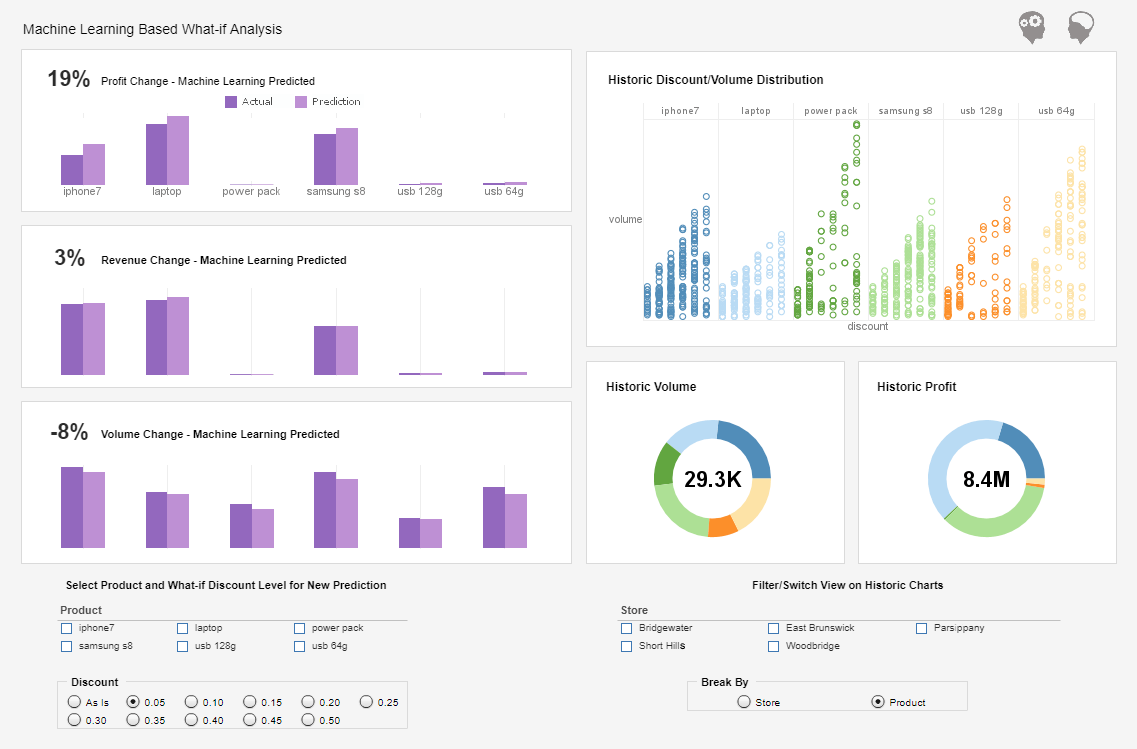InetSoft's Shared Dashboards
Looking for a better solution to share dashboards?
The accelerated growth in the use and ease-of-use of BI tools has created the need for a way to make BI more accessible to users across an organization. InetSoft has answered that need perfectly with StyleBI, a secure, web-based shared dashboard platform which can be accessed by anyone with a web browser.
This highly intuitive, mobile-friendly shared dashboard software consolidates an entire organization's data into a single source of information that can be accessed in the office or out in the field, making it easier to share and analyze actionable findings on a larger scale.
Having a shared dashboard tool available via a web browser enables expanding organizations to make BI accessible to offices all over the globe. The ability to host shared dashboards on a single server or server cluster and make it available to an entire organization eliminates the added costs of hosting individual solutions at different locations.
With the increase in the popularity of cloud computing, and the increase in telecommuting, shared dashboards are fast becoming far more convenient than desktop-based software. A web-based shared dashboard platform enables your employees to easily collaborate on dashboard projects, and makes findings instantly available to all who are granted access.
InetSoft's Software for Sharing Dashboards
InetSoft's robust data mashup engine enables data from many different sources to be combined into single shared dashboards, for the creation of efficient, automated reports, and intuitive, interactive dashboards. InetSoft's advanced capabilities in both visualization and reporting make it stand out from other BI vendors, whose software is usually only capable of one of those two functions.
Access is not limited to users with desktop or laptop browsers, however. InetSoft's web-based interface enables all shared dashboards and reports to be viewed and manipulated on a variety of mobile devices, including iPads, iPhones, Android devices, as well as any smartphone. InetSoft has also released native apps for iPhones and Androids, for faster speeds and additional functionality.
How Do You Share Dashboards in StyleBI?
StyleBI provides several straightforward ways to share dashboards so analytics reach the people who need them — whether that's via a secure intranet link, a public URL, embedding dashboards inside another web app, scheduled export/email, or programmatic access through APIs. The platform emphasizes web-native delivery and flexible embedding so dashboards can be consumed where users already work. :contentReference[oaicite:0]{index=0}
1. Direct links — public or private
The simplest option is to share a dashboard URL. StyleBI supports both public link sharing (for dashboards you want the world to see) and private links limited to your organization or users in a specific domain. This is handy for quick distribution: paste the link into chat, an intranet page, or a ticketing system and viewers open the interactive dashboard in their browser. :contentReference[oaicite:1]{index=1}
2. Embed dashboards into other web pages or apps
For tighter integration—for example, embedding analytics inside an internal portal, customer portal, or SaaS product—StyleBI provides embeddable reporting and OEM-friendly features. You can render interactive dashboards inside an iframe or using the platform’s embedding capabilities, allowing single-sign-on, theming, and contextual parameterization so the dashboard behaves like a native part of your application. This is a common approach when you want analytics to appear inside the workflows users already use. :contentReference[oaicite:2]{index=2}
3. Exporting and scheduled delivery (PDF, Excel, CSV, email)
If recipients need static copies, StyleBI supports exporting dashboards and reports to common formats — PDF, Excel, CSV, etc. — and you can deliver those exports on-demand or via scheduled email. Scheduled delivery is especially useful for daily/weekly operational reports (e.g., morning KPIs) so stakeholders receive the latest snapshot without opening the dashboard themselves. :contentReference[oaicite:3]{index=3}
4. Bookmarks, snapshots and bookmarks-as-views
StyleBI lets users save specific views of a dashboard (bookmarks) so you can share a consistent filtered/parameterized view with another user. Bookmarks are ideal when you want to direct someone to a particular slice of the data (for example: “Sales — Region West — Last 30 days”) and ensure they see exactly what you intended. This is a lightweight way to communicate context without creating a new dashboard. :contentReference[oaicite:4]{index=4}
5. Collaborate in-app: comments, annotations and permissions
For collaborative review, StyleBI includes annotation/comment features and folder-level permissions so you can control who sees or edits dashboards. Rather than sending static screenshots back and forth, team members can annotate a live dashboard, leave notes, and rely on role-based access to protect sensitive metrics. Administrators can set read/write access at the dashboard, folder, or even cell level depending on governance needs. :contentReference[oaicite:5]{index=5}
6. Programmatic sharing and automation via API
If you need automated or programmatic distribution (for example, generating on-demand images or embedding user-specific dashboards from a backend service), StyleBI exposes REST API capabilities so you can integrate dashboard rendering and data retrieval into custom workflows, CI/CD pipelines, or application backends. This is useful for advanced OEM or developer-driven sharing scenarios. :contentReference[oaicite:6]{index=6}
7. Security and single sign-on (SSO)
Sharing options are designed to coexist with enterprise security: StyleBI supports authentication integration (SSO), domain-restricted sharing, and role-based permissions so you can safely embed or link dashboards without exposing confidential data. When embedding dashboards into external systems, tie the embed to authenticated sessions or token-based access to avoid leaking sensitive information. :contentReference[oaicite:7]{index=7}
Best practices for sharing
- Pick the right channel: use direct links for quick access, exports for archival/distribution, and embedding for integrated workflows.
- Control access: always match sharing mode to the sensitivity of the data; prefer domain-limited links or SSO-embedded dashboards for internal metrics.
- Use bookmarks: share specific views rather than asking recipients to recreate filters—it reduces confusion and speeds action.
- Automate thoughtfully: schedule exports for stakeholders who prefer email, but avoid over-notifying—use high-value schedules and concise content.
- Document intent: when you share, include context (what to look at, why it matters, and any actions expected) so recipients don’t misinterpret the visuals.


